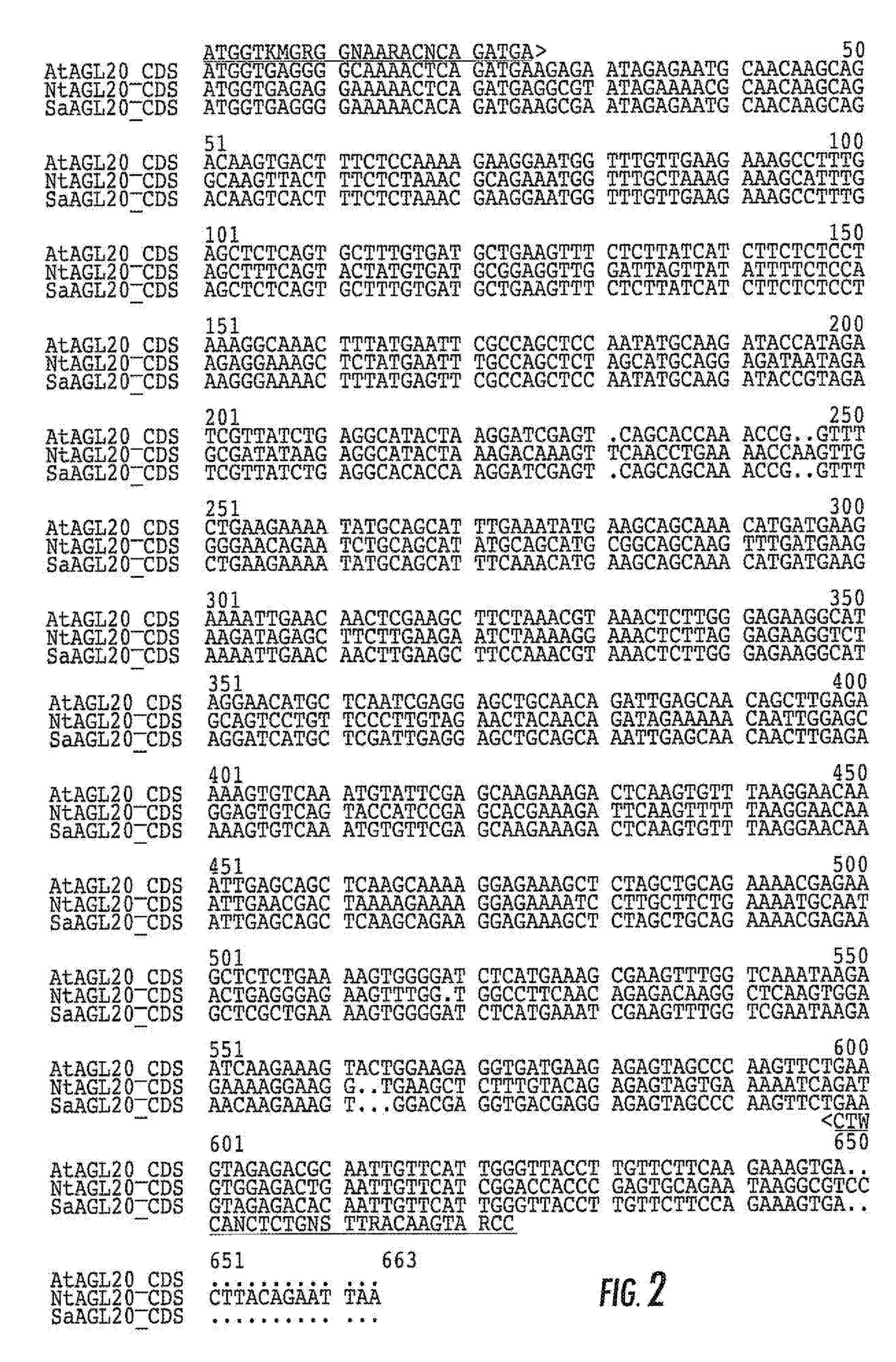Transgenic plants and methods for controlling bolting in sugar beet
a technology of sugar beet and plant, applied in the field of methods and transgenic sugar beet plants, can solve the problems of no plants or methods for predictably delaying sugar beet vernalization, loss of yield, etc., and achieve the effects of suppressing agl20 gene expression, and modulating sugar beet vernalization respons
- Summary
- Abstract
- Description
- Claims
- Application Information
AI Technical Summary
Benefits of technology
Problems solved by technology
Method used
Image
Examples
example 1
Assembly of the Binary Transformation Vector for the Constitutive Expression of FLC in Transgenic Sugar Beet
[0232]The FLC gene cassette is under the control of the constitutive CaMV 35S promoter. The FLC coding region consists of the FLC cDNA from Arabidopsis thaliana (Accession No. AF537203, SEQ ID NO: 3) followed by the mannopine synthase (mas) terminator from Agrobacterium tumefaciens. The gene cassette was introduced as a 2.4 Kb Aso I-Pac I fragment on the T-DNA of the proprietary binary transformation vector pVictorHiNK carrying the SuperMAS::PMI::NOS selectable marker gene for mannose selection in sugar beet (Joersbo et al, 1998), yielding binary vector pHiNK260 (FIG. 1). The complete nucleotide sequence of pHiNK260 is disclosed in SEQ. 1. Upon completion, binary vector pHiNK260 was transformed into Agrobacterium tumefaciens strain EHA101 (Hood et al., 1986) by means of a heatshock as described in Holsters et al., 1978.
example 2
Amplification and Cloning of Homologues from Sugar Beet Beta vulgaris
[0233]2.1 Amplification and Cloning of the Putative FLC Homologue from Sugar Beet.
[0234]In order to amplify and clone the FLC homologue from sugar beet, degenerate primers were designed against the conserved MADS_MEF2-like domain that is present at the NH2 terminus of all Type 2 members of the MADS box family of transcription factors to which FLC belongs (Pa{hacek over (r)}enicová et al, 2003). Degenerate primer HiNK5277 (5′-CGNCGNAAYGGNCTNCTNAARAARGC-3′, SEQ ID NO: 30) targets the conserved amino acid sequence motif “RRNGLLKKA”; primer HiNK5279 (5′-GCNTAYGARCTNTCNGTNCTNTGYGAYGCNGA-3′, SEQ ID NO:31) hybridizes immediately downstream of HiNK5277 and targets amino acid sequence motif ‘AYELSVLCDAE’.
[0235]Total RNA was extracted from sugar beet leaves and apices using the RNeasy Plant Mini kit from Qiagen and converted into cDNA using the FirstChoice RLM-RACE kit from Ambion, Inc. Experimental conditions were essentia...
example 3
Assembly of the Binary Transformation Vector for RNAi Induced Suppression of the AGL20 Gene in Transgenic Sugar Beet
[0238]By means of a strategy known as ‘recombinant-PCR’ (Higuchi, 1990), a 0.28 Kb cDNA fragment consisting of exons 3 to 7 of the AGL20 homologue from sugar beet (SEQ ID NO: 5) was fused to the second intron from the potato ST-LS1 gene (Eckes et al., 1986; Vancanneyt et al., 1990). Care was taken not to include the MADS domain to prevent suppression of other MADS box transcription factors due to the strong sequence conservation of the MADS domain amongst the family of MADS box transcription factors. The BvAGL20 fragment was amplified using primers HiNK792 (5′-CTATGGATCCGCATGCTG ATCTCCTGATC-3′, SEQ ID NO: 8) and 793 (5′-AAGA AGTTAAAAAGTCTCGAAC-3′, SEQ ID NO, 9), the first carrying a short linker to add a BamH I restriction site, the latter carrying a tail of 17 nucleotides complementary to the 5′ end of the ST-LS1 intron (linkers and tails are underlined hereinafter). ...
PUM
| Property | Measurement | Unit |
|---|---|---|
| temperature | aaaaa | aaaaa |
| temperatures | aaaaa | aaaaa |
| temperatures | aaaaa | aaaaa |
Abstract
Description
Claims
Application Information
 Login to View More
Login to View More - R&D
- Intellectual Property
- Life Sciences
- Materials
- Tech Scout
- Unparalleled Data Quality
- Higher Quality Content
- 60% Fewer Hallucinations
Browse by: Latest US Patents, China's latest patents, Technical Efficacy Thesaurus, Application Domain, Technology Topic, Popular Technical Reports.
© 2025 PatSnap. All rights reserved.Legal|Privacy policy|Modern Slavery Act Transparency Statement|Sitemap|About US| Contact US: help@patsnap.com



